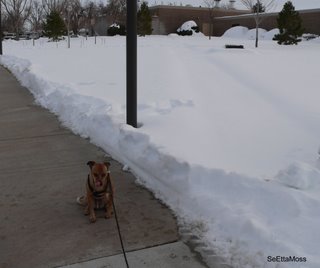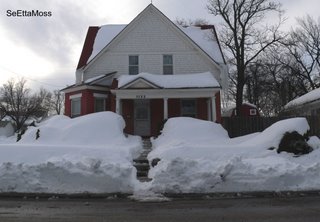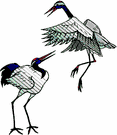Lower Arkansas Valley still snow-jammed


I tried to do some birding in the Rocky Ford and La Junta areas today both before and after a water meeting I had down there. I say "tried" because the lower Arkansas Valley is still snow-jammed and many birding hotspots are inaccessible due to continued deep snow and lakes all frozen over. I had thought that since these lakes are irrigation water impoundments, and they get filled with water in the winter, that at least the intake area of the lakes would be open--not so.
First I stopped at the Rocky Ford Valco pond but it was frozen over with no birds around. The towns of Rocky Ford, Swink (that really is it's name) and La Junta still have not only large piles of snow where it has been pushed or dumped and large drifts, but also just a continuing significant dept of snow cover. As can be seen in these photos I took in La Junta, the snow cover is more than a foot deep and sometimes over 2 feet deep. The dog in the pic is Chase, my red-speckled cowdog/rat terrier mix, who provides some context for measuring snow dept. I saw similar snow depts in the surrounding countryside.
I tried Lake Cheraw but I couldn't get very close due to deep snow. I was finally able to ascertain that the lake was totally frozen-over. I found the same at Lake Holbrook.
I did see a number of hawks (the ones I identified were all Red-tailed Hawks) and some Western Meadowlarks as I drove around. Also there were several flocks of passerines that I saw flying. I did see more birds in areas with less deep snow cover.
The fact that there is still such an almost complete snow cover that is mostly 1-2 foot deep a full 10 days after the snow stopped falling is extremely unusual. SE Colorado usually warms up so that the sun melts the snow much faster and often warm winds (called chinooks, which means "snow eaters") increase evaporation.
Hopefully ground-dwelling birds and small mammals dug themselves out of the snow early on as now that it has melted some there it is getting harder.
SeEtta










